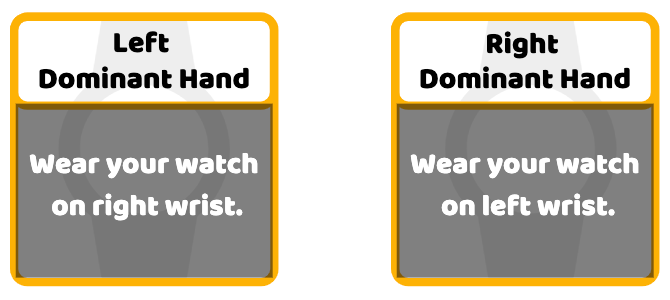If you are a watch enthusiast like me, you have probably noticed that a vast majority of people wear their watches on the left wrist. Due to this trend, the common assumption is that all of us should. In this article, I’m going to explain what’s the reasoning behind this and if it is really necessary for us all to follow the same guidelines.
A fun fact before we begin: there are over 7.7 billion people in the world. It is estimated that more than 90% of the population is right-handed, leaving just under 10% for the “lefties”. At this point you might think: if this is so, why am I supposed to wear the watch on the left wrist?
The short answer is: to keep your watch safe from damage, easy to check and set the time. Continue reading the learn exactly why we should be wearing a watch on the opposite of our dominant hand.
What Wrist Does Your Watch Go On? General Rule

As explained earlier, you should wear your watch on the wrist opposite to the one you are naturally using. There are no specia
l benefits of wearing a watch on the right hand. Nor there are any when we do the opposite.
If, like the majority of the population, you are a right-hander, wear your watch on the left wrist. If left-handedness is your thing, do not care about the general (and somehow wrong) assumption and put it on your left wrist. I’m encouraging you to do so because there seem to be some insecurities amongst right-hand watch users. I’ve even come across ideas that there’s some kind of negative psychology of wearing a watch on the right hand. Let me tell you, there’s not.
Many people, although not all, seem to already follow the “right way” according to this poll. If you are currently not, continue reading to learn why it’s important to start doing so.
Why do many people think a watch should be worn on the left, no matter what?
Contrary to reports, humans are a relatively simple species. They do what the majority of society does, often without even thinking about questioning the “norms”.
Since the invention of the first wristwatch in the 20th century, people started putting it on their left hand, and… they never stopped. The biggest reason for it is the crown of the watch.
Especially in the early years of wristwatches, all of them had a crown so the watch could be wound. The crown was (and in many cases still is) always put on the right side of the watch case. If you were a right-hander, winding such a watch was a walk in the park. Now imagine that the left is your dominant hand. Trying to wind such a watch on your right wrist would be a struggle, to say the least.
The crown was and still is the biggest reason why a vast majority of users, even the left-handers, put the watch on their left wrist – no matter what. Is it the right thing to do, though?
In my opinion, shared by many experienced watch enthusiasts, protecting your watch from damage is far more important than being able to comfortably wind it on your wrist. You can always take off the watch for a minute to make the process easier for you. How often do we wind a watch, anyway?
Another valid point is, fewer people wear watches that need winding. What’s more, this decade will see an unprecedented amount of users ditching the “old-school” watch in favor of wearables (smartwatches).
If all of this sounds confusing and you still wonder what hand does a watch go on, continue the lecture. Below I explain why you shouldn’t feel discouraged to wear your watch on the right if you are left-handed.
Why a Watch Should Be Worn On The Opposite Wrist
There are many reasons why a watch should be worn on the opposite of our “natural” hand. And I think all of the points listed below strongly outweigh the arguments of the “left wrist no matter what” theory.
Protection against physical damage
It’s only natural to assume that your dominant hand is being much more exploited during your everyday tasks.
Even the most basic activities bring dangers of damaging your watch in some way, let it be a scratch on the case or even a crack on the dial window. Replacing any of the two is a burden (very often an expensive one), so why take the risks?
If you are a fan of bigger-sized watches like the Casio G-Shock series, simplest tasks like writing or checking your pocket can prove problematic. The same issues might arise when you are trying to eat or even brush your teeth.
Protection against mechanical damage
Even the most durable watch movements are just that, durable. They are not bulletproof by any means.
If you are wearing a watch on your “natural” hand instead of the opposite, the watch is prone to many more mechanical shocks. Unless the watch is shock-resistant, damaging or even completely breaking the watch movement is a strong possibility.
As an example: if you are a construction worker wearing a watch on your dominant hand and using a hammer is something you do every day, then chances are you will have to replace your watch sooner than expected. Other “endangered” professions include mechanics working at repair shops, plumbers, etc. The same can be said about some of the leisure activities we love (ie. badminton).
Easier to check the time
Right-handed people will do 99% of their daily work with their right hand whereas left-handed people will do the opposite. Putting off or pausing basic activities like moving the mouse pad, eating or going through some papers just to check the time, as ironic as it sounds, would be a waste of time.
Different Rules of Wearing Watches for Males & Females?
Many people wondering what hand does a wristwatch go on, also wonder if there are different sets of “rules” for men and women.
What wrist does a watch go on a male?
The shortest answer possible is: men should simply stick to the rules mentioned above. As long as you avoid wearing the watch on your dominant hand to avoid it wearing off too quickly, it’s all good.
What wrist does a watch go on a female?
Although there are no different rules for how to wear a watch for ladies, in some circumstances, a different approach should be considered.
Sometimes you might see and wonder why ladies wear a watch on the right hand. If you are a female that loves carrying tons of jewelry, you might want to consider putting your watch on the wrist that’s free of it. Thanks to this, you will minimize the risk of scratching your watch against jewelry (and vice-versa).
In the perfect world, you’d like to wear your jewelry on the wrist of your dominant hand whereas the timepiece is on the other.
Watches for Left-Handers
People with a dominant left hand should no longer feel left out. Gone were the days when the only watch structure included the right-side crown. Nowadays, more and more brands produce watches designed exclusively for left-handed people.
Here, let me again stress that the importance of the position of the crown has been decreasing over the years anyway. With the introduction of smartwatches and the ever-growing popularity of digital ones, left-handers can comfortably wear any watch on their right wrist.
Nevertheless, it’s worth mentioning that there’s a growing trend amongst brands, especially the luxury ones, in offering left-handed watches. These brands include such names as Tudor or Rolex. Also, more affordable names such as Citizen and Invicta have started releasing more models for the “lefties”.
Left or Right? Conclusion
I truly hope that my explanation has shed enough light on what wrist should your watch go on.
To summarize, I’d like to once again encourage you not to worry about what most people think. Now that you have the wisdom, follow the rules specified in this article. Thanks to them, your watch will have a great chance of serving you well for much longer.
From now on, try to always wear the watch on the opposite of your dominant hand. A right-hander? Put your timepiece on the left. A left-hander? Do the “weird” thing and place it on the right.
If for whatever the reason either of the above feels uncomfortable and unnatural for you, you can always follow the approach of Laissez-Faire… by wearing it just as you wish, not caring about what others think and what the rules are. After all, it’s your watch. And your style.

